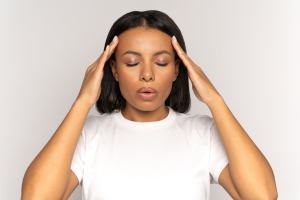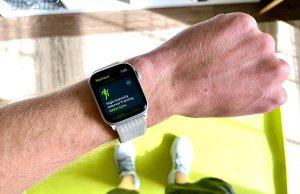Most of us aren’t exactly thrilled about having to give a presentation to our entire company. We might feel slightly awkward having to make small talk with a stranger. Perhaps we get the jitters before a blind date. But we’ll still complete that presentation, engage in chit-chat, and go out to meet that cute new person—because after all, it’s normal to have a little social anxiety.
But when you have social anxiety disorder, these things can feel unbearable. Whether you think you have the condition or you’re trying to better understand it, here’s a compilation of key facts about what social anxiety really looks like and what can help. In addition, you’ll learn that with the right treatment, those who are suffering from social anxiety can build deeper bonds with others, and create a satisfying life that isn’t ruled by anxiety.

What Is Social Anxiety Disorder?
Social anxiety disorder, also called social phobia, is a type of anxiety disorder characterized by an intense fear of social interactions. This disorder usually starts in early adolescence but can begin at any age. Social anxiety is a type of fear that is irrational, with no specific cause or reason for the anxiety.
Those with social anxiety disorder may also worry about doing something that offends others or humiliates themselves. Or worse, that they’ll be rejected. Like other anxiety disorders, social anxiety can kick-start a vicious cycle.
What Are the Symptoms of Social Anxiety Disorder?
Besides an intense fear of social interactions, rejection, and potential humiliation, social anxiety disorder can have both psychological and physical symptoms. Common social anxiety disorder symptoms include:
- Accelerated heartbeat
- Blushing
- Dizziness
- Feeling like your mind is going blank
- Headaches
- Feared situation withdrawal or shutting down
- Weak bladder or urinary frequency
- Muscle tension
- Shaking
- Sick-to-your-stomach feeling
- Sweating
- Having full-blown panic attacks
At the heart of social anxiety resides the terror of being perceived in a bad light. Someone with social anxiety disorder fears that others will think they’re stupid, boring, less-than, awkward, or weak (or insert some other awful adjective here).
How Is Social Anxiety Disorder Diagnosed?
Social anxiety can feel like apprehension when approaching social situations, spending more time worrying what others are thinking or how one is being perceived than actually present in social situations. It can present as tension, worry, rumination, anxious mood, sweating, nausea, feeling your heartbeat, or shallow breathing.
Some of the psychological signs of social anxiety disorder can involve:
- Assuming others have exceptional social and performance skills in comparison to yourself
- Assuming you’ll say or do the wrong thing
- Believing you need alcohol or other substances to deal with a social situation
- Fearing your body will freak out with an embarrassing reaction, such as shaking in your voice or hands and sweating nonstop
- Having worst-case-scenario, negative thoughts: What if I bomb the presentation and everyone thinks I don’t deserve the position? What if it’s super obvious I’m a nervous wreck? What if I can’t stop stuttering?
- Picking apart a past performance or interaction and inevitably finding a slew of flaws
What Causes Social Anxiety Disorder?
No one is sure what exactly causes social anxiety disorder (or most disorders for that matter). But it’s likely a combination of contributing factors, including genetic and environmental factors, such as:
- Close family members with social anxiety, who either give a genetic risk or inadvertently model anxious social behavior
- A history of stressful events, such as bullying, teasing, family conflict, or trauma
- An overactive amygdala—the emotional center of our brains involved in fight or flight—which sharpens anxiety in social interactions
- Controlling or overprotective parenting styles that leave children unprepared to handle challenges or responsibilities on their own
- Physical deformations, such as scars, burns, amputations, or other marks that cause someone to become self-conscious, especially if others have made insensitive remarks about their appearance
- Being overweight, a person of color, or a member of the LGBTQIA+ community
Is Social Anxiety Disorder Common?
Social anxiety disorder is actually quite common, affecting 15 million Americans (6.8%). It’s the second most common anxiety disorder, after specific phobias.
The true number of people suffering from social anxiety disorder could actually be far higher, as many people underreport their symptoms, experiencing shame, or worrying about the stigma of seeking treatment from a mental health professional. Social anxiety can affect both men and women alike.
What Triggers Social Anxiety?
Social anxiety can be triggered by any social situation, or any situation in which you and at least one other person are present. The two main categories of social situations are performance (where you feel as if you’re being observed by others) and interpersonal (where you directly interact with others).
Performance situations include giving a presentation, walking into a room full of people, and talking or asking a question in a meeting/class. Interpersonal interactions include meeting new people, talking to friends, going to a party, and ordering at a restaurant.
It’s normal for people with social anxiety to fear certain social situations but not others. For example, you might feel completely comfortable interacting with friends and family but feel anxious and uncomfortable around strangers.
Perhaps only one social scenario might trigger your anxiety, such as public speaking—or maybe a wide variety of situations could set off your symptoms, including crowds, dates, airports, and other specific situations that may often be encountered.
Social anxiety can be particularly challenging because interacting with other people is typically how we communicate our personality, our needs, and progress forward professionally, romantically, and interpersonally. When social anxiety disorder gets in the way, this can cause significant distress to the person suffering from it.
What Age Does Social Anxiety Start?
Social anxiety can begin at any age, because the factors that contribute to its development are highly unique—however, as stated previously, symptoms typically manifest in childhood or adolescence. This can be for a variety of reasons, but may involve increased complexity in social interactions and interpersonal relationships that cause someone to become more self-conscious.
Adolescence in particular, is a time when teens start to form their own identities, and if they’ve suffered from trauma, bullying, or another issue.
How Do I Manage My Social Anxiety?
Talk to a professional, who can help you understand and treat your social anxiety disorder symptoms. Medication can be very helpful, and therapy can support coping skills, distress tolerance skills, reframing your thinking, and practicing mindfulness and many other tools to help reduce anxiety and even increase enjoyment in social settings.
Along with these therapeutic interventions, lifestyle changes are often necessary in curbing the negative effects of social anxiety disorder, as well. This might mean changing your dietary habits, your sleeping habits—even your body language and social media content consumption, as well.
Read more below about the specific treatment options available for social anxiety disorder symptoms, including social anxiety disorder medication and therapy.
Can Social Anxiety Be Cured with Therapy?
While there isn’t a “cure,” effective treatment can put the related symptoms into remission. This typically involves cognitive behavioral therapy (CBT) treatment for social anxiety disorder symptoms.
CBT is one of the most popular, well-established, and proven forms of therapy, and can offer people who are suffering from social anxiety disorder the coping strategies and clarity they need to manage the intense fear, worry, and panic they might experience during triggering social interactions.
CBT treatment for social anxiety disorder symptoms can include:
- Learning to identify negative thought patterns that have become attached to certain social scenarios and environments. This might be done through talking in sessions as well as personal journal entries that can reveal more about one’s reactions and inner feelings when they’re experiencing social anxiety disorder symptoms in public.
- Replacing negative thought patterns with more realistic and positive thoughts. For example, if someone becomes nervous while speaking or presenting in front of coworkers, CBT might help them learn to focus on their professional merits, the positive relationships they have formed at work despite their anxiety, and more. They might also learn to see their anxiety as arising from their inner emotions and dialogue, a process over which they can have control.
- Real-world problem-solving techniques to use in the situations that provoke their social anxiety disorder symptoms. Clients will encounter real-life scenarios that will test what they’ve learned in CBT. Being able to actively work through obstacles is crucial to long-term success after ending CBT. This often involves recognizing the issue, creating a list of possible solutions they have learned, determining which possible remedy fits best, choosing that remedy, and then finally implementing it.
Depending on the intensity of someone’s social anxiety disorder symptoms, they may also receive psychiatric treatment to help them address the anxious thoughts and physical symptoms they’re struggling with.
What Social Anxiety Disorder Medications Are Available for Clients?
Social anxiety disorder medications are available as a sole form of treatment, or as a compliment and supportive addition to CBT therapy, or another form of counseling. Many antidepressants can also be used as anxiety medications, including:
- SSRIs or SNRIs
- Benzodiazepines
- Buspirone
- Hydroxyzine
- Beta-blockers
The social anxiety disorder medication that’s prescribed to you may vary, depending on your symptoms, their severity, and your provider’s policy for prescribing certain medications. The benefits that you experience may vary as well, but in general, you can expect to enjoy:
- Improved concentration
- Improved sleep
- Better emotional regulation skills during social interactions
- Improved critical thinking skills
- Decreased anxious mood and fewer worries
- Decreased physical symptoms of anxiety like sweating, fidgeting, or nervous tics
- Improved social skills
- Improved job performance
Though social anxiety disorder medications are typically effective at reducing the frequency and severity of someone’s social anxiety, results can be different for everyone. Social anxiety disorder is a complex condition that requires real-world changes, too—but these can often be easier to implement with help from a psychiatric provider, alongside a therapist.
And as with addressing any other mental health condition, the first step is recognizing that social anxiety disorder is causing significant issues and creating challenging barriers in your daily life. Progressing past these roadblocks is entirely possible, though; and you don’t have to do it alone.













